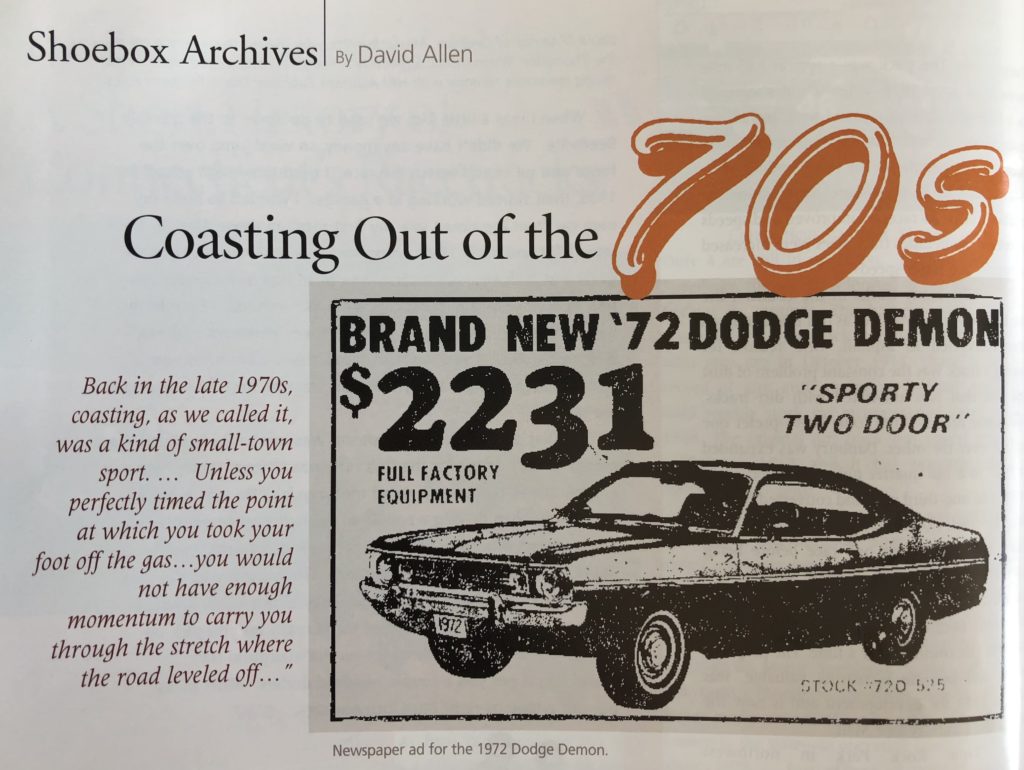(c) Connecticut Explored Inc. Spring 2008
Subscribe/Buy the Issue!
Though I grew up in Preston, Connecticut, I now live in Queens, New York. I sold my car a few years ago. Keeping a car on the city streets was becoming more of a burden than a convenience, let alone a pleasure. This seems almost unthinkable for somebody who grew up in the small town of Preston in the 1970s, when having a car was a lifeline. In 1979, when I was 18, I inherited the use of a chocolate brown (to put it kindly) 1972 Dodge Demon with “three on the tree” (and a tendency to stick between first and second gears). My father had bought it “stripped,” in other words, no options, not even a radio. Despite that, the car had been similarly prized by my older brother and sister.
That year, the price of gas was around 85 cents a gallon. The Demon got about 16 miles per gallon, so I paid for gas a dollar or two at a time earned at various afterschool jobs. “Regular” was a few cents a gallon cheaper than the “unleaded” gas that the new Japanese imports took. It was gas crisis time, and, for a brief period, you had to remember to fill up on an “even” or “odd” day, depending on the digit your license plate ended in.
I had plenty of adventures in that Dodge Demon, some I’d rather forget. But a recent conversation with my nearly-90-year-old father took me back to a brighter side of those days. He was telling me about a stretch of road where he could “roll” for about a mile and a half with his new Toyota Corolla in neutral, without touching the accelerator at all.
Back in the late 1970s, coasting, as we called it, was a kind of small-town sport. Maybe it was the rising price of gas or the natural cheapness we inherited from our Depression-era parents, but my brothers and I loved to coast; I’m not sure about my sisters. To do it well, you needed to find a stretch of road that had a long incline, preferably one that zigged and zagged to make it interesting. It needed to be quiet, since cars coming up behind you could force you to put the car in gear, thus terminating the run prematurely.
There were some good runs in Preston, one of which allowed you to dip into North Stonington before crossing back into town. By far the best one, though, was the stretch of road my older brother found coming back from the submarine base in Groton. What made it particularly great was that, unless you perfectly timed the point at which you took your foot off the gas and controlled the speed you were going, you would not have enough momentum to carry you through the stretch where the road leveled off between two fields and make it to the point where you started rolling downhill again. You could try opening the door and pushing off with a foot—or two if you had a passenger—or, if you mistimed it completely, you had to concede defeat and put the car in gear. But if you got it just right, you would creep along, nearly coming to a stop, before slowly, slowly picking up speed until you were flying again, using the brakes only at the stop sign where the road met Route 2A in the middle of Poquetanuck Village.
The Demon was the undisputed champion coasting car. We had a variety of Valiants, a Hornet, and a Vega, but none of them had the ideal mass and weight distribution for the job. At least, that was our theory. When, after I had gone to college, my parents sold the Demon for a couple hundred dollars, I knew my coasting days were over. So the conversation with my dad took me by surprise: pushing 90, he was still coasting! Maybe, after all, coasting is not a lost art. Maybe, even now, some kid in his second-hand Subaru or Saturn has found that particular stretch of Avery Hill Road. I can still picture the exact point in the stone wall at the top of the curve of the hill where you give it the gas one last time, throw it into neutral, and let it go.
David Allen is an education researcher and writer.
Explore!
Read all our stories from the Fall 2008 issue.
Read all of our transportation history stories by clicking on the category link at the top of the page.

